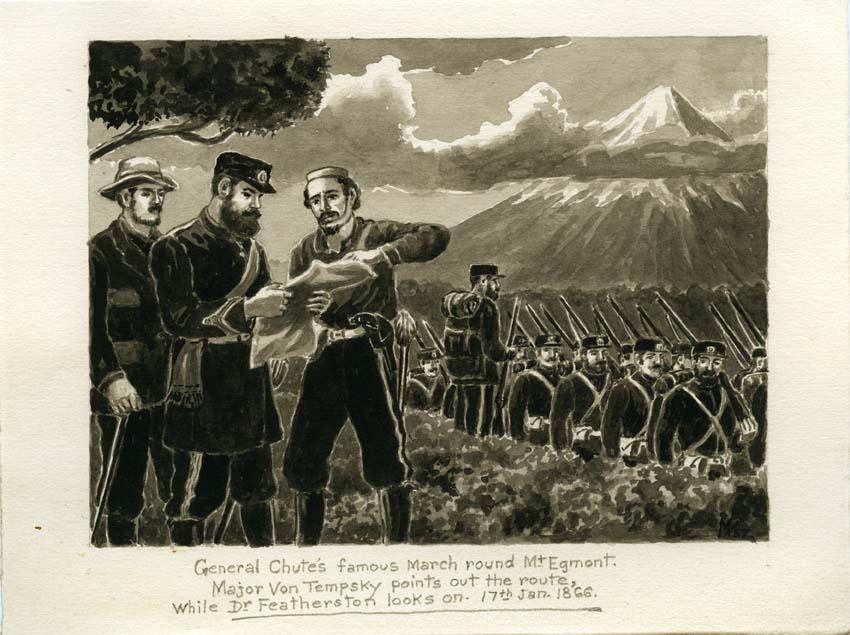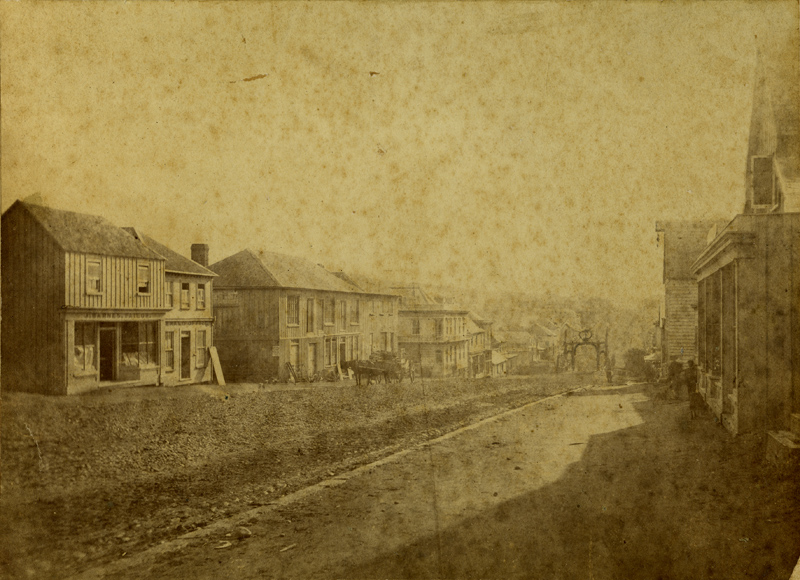

General Trevor Chute had all the coolness of an experienced British officer. He waited with quiet anticipation as the steamer pulled alongside the Whanganui wharf. He knew the quality of the men on board would determine the end result of his new campaign, carried out under Government orders. Chute had been given the task of leading the troops into battle to quell the Hauhau rebels.
Chute liked what he saw. Along with Lieutenant-Colonel McDonnell and Kepa, a Māori militiaman, he assembled a force of 700 men. All were paid 2s 6d plus free rations for the privilege of going to war and they carried Enfield rifles and Calisher & Terry carbines. His corps, the Forest Rangers under the command of Major von Tempsky and McDonnell's Native contingent; were made up of an even number of Pākehā and Māori.
According to the men who knew him, the General was a man of great energy who never created unnecessary problems or worried about any in the future. 'Neither did he allow a few lives to stand between him and his objectives.' Described as 'a robust, plump man' with a full beard more likely to be found on a naval petty officer, they admired him for his vigour on the battlefield and his quick decision-making. What was even more admirable, they said, was that he was not frightened of bush-fighting. And the Hauhau warriors could not be defeated, unless troops were ready to fight them in the forest.
On 7 January 1866, Chute led an attack on the fortified village Te Putahi, and then stormed Otapawa pā. When a live bullet ripped the braiding from his tunic, his only retort was to his soldiers: 'Go on, boys!'
Next Chute destroyed a Hauhau settlement at Ketemarae. Though his troops suffered casualties, they inflicted more damage than they received. Soon Chute's advancing army wiped out every settlement it came to, torching whare, destroying garden plots and killing anyone who resisted at Kiteonetea, Puketi, Weriweri, Te Whenuku...
In 6 weeks, Chute cleared the area from Whanganui to New Plymouth, an operation his predecessor General Cameron had expected would take two years. “During these operations, General Chute displayed every quality of a great General” Governor Grey said.
Having conquered Ketemarae, the present site of Normanby, Chute rested for a whole day. Next morning he planned to start off on a trail-blazing expedition to forge a track around the mountain, Taranaki.
Settlers were very keen to establish a direct link from Hāwera to New Plymouth. For 20 years Pākehā had dreamed of finding an alternative route so they wouldn't need to make the arduous trek via the Taranaki coastline. A road running east of the mountain, connecting north Taranaki to south Taranaki, would benefit all those involved in developing the province.
General Chute decided he was the one to forge that passage. With an excellent army of men already camped at the place the inland road should start from, and warm sunny weather, what better opportunity to stamp his footprint on the country?
Māori had long known how to move swiftly between the two coasts, and warriors spotted in south Taranaki often popped up suddenly without warning in the north. Whispers had always been heard of a secret track.
Since ancient times, Ketemarae had been a favourite gathering place for tribes, a 'junction of old war-tracks'. Though no tracks could be seen, an old pathway did exist; the Whakaahurangi track, the one Dicky Barrett and Te Ātiawa had used on their great journey south to Kapiti.
Chute's interpreters questioned Māori comrades with no results. They had decided not to share their knowledge with the white man in case it was one day used against them. The General, tired of being stonewalled, set out regardless.
Mood in the camp was good. After three weeks of successful fighting, soldiers still had two and a half day's rations left, more than enough for an estimated 96 kilometre walk through the woods. “We will enter New Plymouth from the bush” Chute told them. There they would be received as heroes and given a fine civic reception. He sent a letter on a supply ship heading to New Plymouth to tell the city fathers to expect them.
On 17 January 1866 Chute mobilised 500 men, 67 pack-horses and 24 saddle horses for his officers, and set a straight course for New Plymouth. Except for the officers, everyone else walked. In celebration of the march, people in New Plymouth decked a hall with bunting, cooked an entire banquet and wrote luminous words of congratulation. But soon the meat lay cold in the serving dishes. The ship had taken just a day to deliver the advance warning, so the troops could not be more than 24 hours behind. Where were they?
All those gullies and rivers! All those steep gorges, running like spokes of a wagon wheel down the sides of Taranaki! All that rain, dashing down! All that bush, tangled vines, matted forests! As the men were about to discover, 96 kilometres on a flat map made many more on the ground and most of them were vertical. The horses baulked at such steep descent!
By Sunday 21 January, three days after it began, the army had covered just 6 kilometres, though they had already crossed swift torrents and chiselled hills. Men fell into bed wet and rose wet at dawn, up to the eyebrows in cold and damp. When rations ran out, as they quickly did, there was nothing to do if they wanted to eat, but butcher two of the horses.
As Lieutenant Carre wrote in a letter home: “It began to look certainly very horrible, for no one knew where we were. We had to eat our horses, and the rain prevented our lighting fires to cook that unpalatable fare.” The Times Office, Whanganui, reported a more cheery soldier's account: “...another horse killed, which went down in fair style. Soups, steaks, chops, roast and boiled... the heart was reserved for the General, but the supply was abundant for all.”
By nightfall on day five, Chute knew he and his men were in trouble. By noon on day six, trouble had certainly arrived. The men were chilled to the bone. There was still only horsemeat to eat. In desperation, a party struck out for New Plymouth to get help.
Ten men tramped to the point of near-collapse, as rain filled their boots and battered their faces. One comrade was abandoned under a tree, but the others ploughed on. Eventually, the remaining nine men cleared the bush, where they fell into the arms of soldiers sent from town to find them.
Finally, on the morning of 27 January, Chute marched into New Plymouth at the head of his weary force, across the Huatoki bridge and through an Arch of Triumph erected in his honour. He was met by the Superintendent of New Plymouth, who offered him a sumptuous dinner and these words: “Sir...your march inland of Mt Egmont is the first by a large body of regular troops through the difficult forests of New Zealand... it is gratifying to see the happy issue of these first bold movements... they have shown that British corps and British armies, can penetrate wherever man can hide; and that the only course open to the hostile natives is frank submission to the just and equal laws which the Empire and the colony hold out for their acceptance...”
It is said the General accepted this with all due modesty.
Puke Ariki Heritage Collection: Trevor Chute
LinkPlease do not reproduce these images without permission from Puke Ariki.
Contact us for more information or you can order images online here.